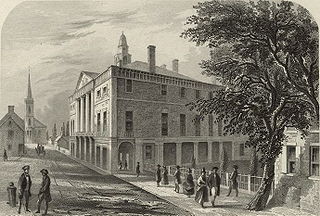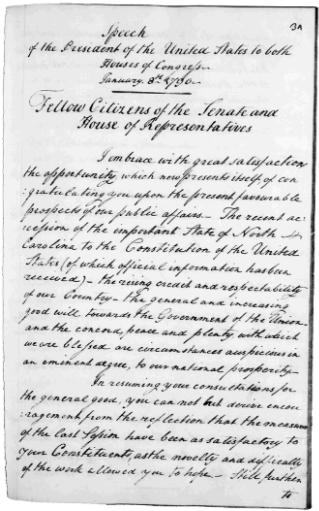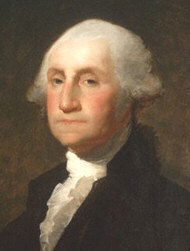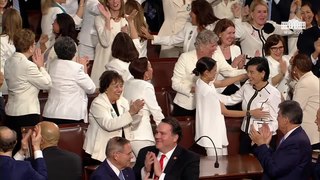
George Washington was an American Founding Father, military officer, and politician who served as the first president of the United States from 1789 to 1797. Appointed by the Second Continental Congress as commander of the Continental Army in 1775, Washington led Patriot forces to victory in the American Revolutionary War and then served as president of the Constitutional Convention in 1787, which drafted and ratified the Constitution of the United States and established the U.S. federal government. Washington has thus been known as the "Father of his Country".

The State of the Union Address is an annual message delivered by the president of the United States to a joint session of the United States Congress near the beginning of most calendar years on the current condition of the nation. The State of the Union Address generally includes reports on the nation's budget, economy, news, agenda, progress, achievements and the president's priorities and legislative proposals.

The 1792 United States presidential election was the second quadrennial presidential election. It was held from Friday, November 2, to Wednesday, December 5, 1792. Incumbent President George Washington was elected to a second term by a unanimous vote in the electoral college, while John Adams was re-elected as vice president. Washington was essentially unopposed, but Adams faced a competitive re-election against Governor George Clinton of New York.

The 1st United States Congress, comprising the United States Senate and the United States House of Representatives, met from March 4, 1789, to March 4, 1791, during the first two years of George Washington's presidency, first at Federal Hall in New York City and later at Congress Hall in Philadelphia. With the initial meeting of the First Congress, the United States federal government officially began operations under the new frame of government established by the 1787 Constitution. The apportionment of seats in the House of Representatives was based on the provisions of Article I, Section 2, Clause 3, of the Constitution. Both chambers had a Pro-Administration majority. Twelve articles of amendment to the Constitution were passed by this Congress and sent to the states for ratification; the ten ratified as additions to the Constitution on December 15, 1791, are collectively known as the Bill of Rights, with an additional amendment ratified more than two centuries later to become the Twenty-seventh Amendment to the United States Constitution.

The 2nd United States Congress, consisting of the United States Senate and the United States House of Representatives, met at Congress Hall in Philadelphia, Pennsylvania, from March 4, 1791, to March 4, 1793, during the third and fourth years of George Washington's presidency. The apportionment of seats in the House of Representatives was based on the provisions of Article I, Section 2, Clause 3 of the United States Constitution. Additional House seats were assigned to the two new states of Vermont and Kentucky. Both chambers had a Pro-Administration majority.
The "Plan for Establishing Uniformity in the Coinage, Weights, and Measures of the United States" was a report submitted to the U.S. House of Representatives on July 13, 1790, by Secretary of State Thomas Jefferson.

Washington's Farewell Address is a letter written by President George Washington as a valedictory to "friends and fellow-citizens" after 20 years of public service to the United States. He wrote it near the end of the second term of his presidency before retiring to his home at Mount Vernon in Virginia.

The Flowing Hair dollar was the first dollar coin issued by the United States federal government. The coin was minted in 1794 and 1795; its size and weight were based on the Spanish dollar, which was popular in trade throughout the Americas.

A joint session of the United States Congress is a gathering of members of the two chambers of the bicameral legislature of the federal government of the United States: the Senate and the House of Representatives. Joint sessions can be held on any special occasion, but are required to be held when the president delivers a State of the Union address, when they gather to count and certify the votes of the Electoral College as the presidential election, or when they convene on the occasion of a presidential inauguration. A joint meeting is a ceremonial or formal occasion and does not perform any legislative function, and no resolution is proposed nor vote taken.

The 1792–93 United States House of Representatives elections were held on various dates in various states between August 27, 1792, and September 6, 1793. Each state set its own date for its elections to the House of Representatives before the first session of the 3rd United States Congress convened on December 2, 1793. With the addition of the new state of Kentucky's representatives, and the congressional reapportionment based on the 1790 United States census, the size of the House increased to 105 seats.

The presidency of George Washington began on April 30, 1789, when Washington was inaugurated as the first president of the United States, and ended on March 4, 1797. Washington took office after the 1788–1789 presidential election, the nation's first quadrennial presidential election, in which he was elected unanimously by the Electoral College. Washington was re-elected unanimously in the 1792 presidential election and chose to retire after two terms. He was succeeded by his vice president, John Adams of the Federalist Party.

The 2002 State of the Union Address was given by the 43rd president of the United States, George W. Bush, on January 29, 2002, at 9:00 p.m. EST, in the chamber of the United States House of Representatives to the 107th United States Congress. It was Bush's first State of the Union Address and his second speech to a joint session of the United States Congress. Presiding over this joint session was the House speaker, Dennis Hastert, accompanied by Dick Cheney, the vice president, in his capacity as the president of the Senate.

The Congressional Apportionment Amendment is a proposed amendment to the United States Constitution that addresses the number of seats in the House of Representatives. It was proposed by Congress on September 25, 1789, but was never ratified by the requisite number of state legislatures. As Congress did not set a time limit for its ratification, the Congressional Apportionment Amendment is still pending before the states. As of 2024, it is one of six unratified amendments.

The Perpetual Union is a feature of the Articles of Confederation and Perpetual Union, which established the United States of America as a political entity and, under later constitutional law, means that U.S. states are not permitted to withdraw from the Union.

The second inauguration of George Washington as president of the United States was held in the Senate Chamber of Congress Hall in Philadelphia, Pennsylvania on Monday, March 4, 1793. The inauguration marked the commencement of the second four-year term of George Washington as president and of John Adams as vice president. The presidential oath of office was administered to George Washington by Associate Justice William Cushing. This was the first inauguration to take place in Philadelphia, and took place exactly four years after the new federal government began operations under the U.S. Constitution.

The first 1790 State of the Union Address was the inaugural State of the Union address delivered by President George Washington to the United States Congress on January 8, 1790, at the Senate Chamber of Federal Hall in New York City.

The state of union is an address, in the United States, given by the president to a joint session of Congress, the United States House of Representatives and United States Senate. The United States constitution requires the president "from time to time give to the Congress Information of the State of the Union." Today the state of the union address is given as a speech, though this is not a requirement of the constitution. George Washington chose to address the congress in a speech annually; on October 25, 1791 he gave his third speech.
The 1796 State of the Union Address was given by George Washington, the first president of the United States, on Wednesday, December 7, 1796. It was given in Congress Hall, Philadelphia. He gave it directly to Congress. He began with, "In recurring to the internal situation of our country since I had last the pleasure to address you, I find ample reason for a renewed expression of that gratitude to the Ruler of the Universe which a continued series of prosperity has so often and so justly called forth." He ended with, "God's providential care may still be extended to the United States, that the virtue and happiness of the people may be preserved, and that the Government which they have instituted for the protection of their liberties may be perpetual."
The 1793 State of the Union Address was given by George Washington, the first president of the United States. It was given in Philadelphia, Pennsylvania at Congress Hall. Washington stood before the 3rd United States Congress on Tuesday, December 3, 1793, and said, "While on the one hand it awakened my gratitude for all those instances of affectionate partiality with which I have been honored by my country, on the other it could not prevent an earnest wish for that retirement from which no private consideration should ever have torn me." He ended with, "Permit me to bring to your remembrance the magnitude of your task. Without an unprejudiced coolness the welfare of the Government may be hazarded; without harmony as far as consists with freedom of sentiment its dignity may be lost."

The 2019 State of the Union Address was given by the 45th president of the United States, Donald Trump, on February 5, 2019, at 9:00 p.m. EST, in the chamber of the United States House of Representatives to the 116th United States Congress. It was Trump's second State of the Union Address and his third speech to a joint session of the United States Congress. Presiding over this joint session was the House speaker, Nancy Pelosi, accompanied by Mike Pence, the vice president, in his capacity as the president of the Senate.















